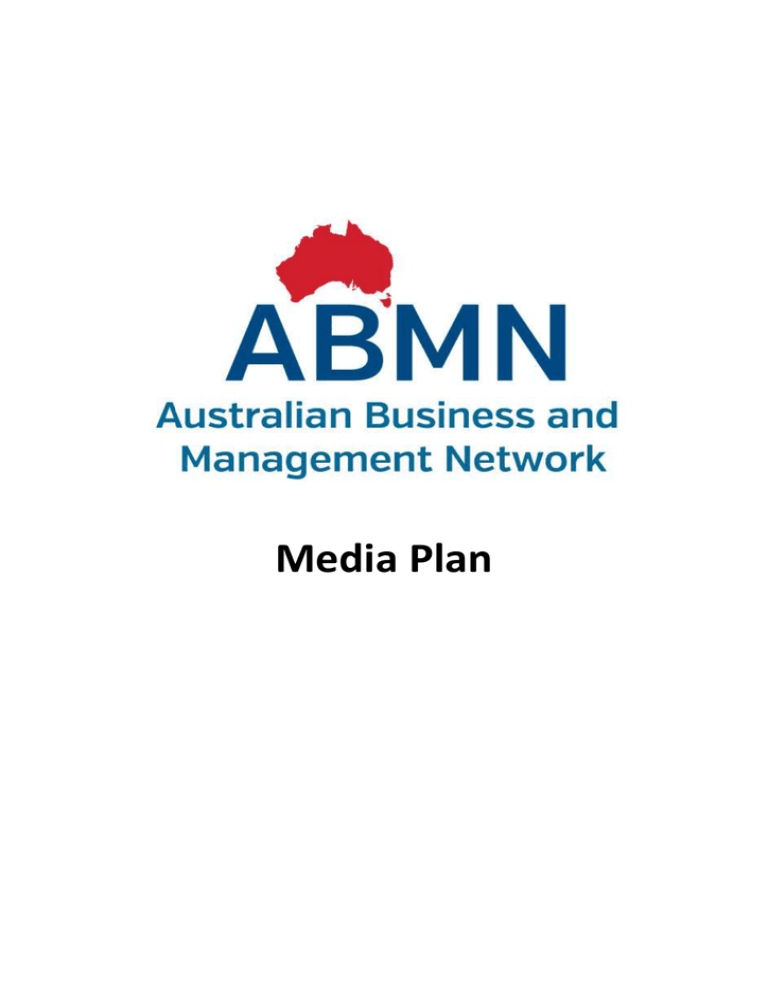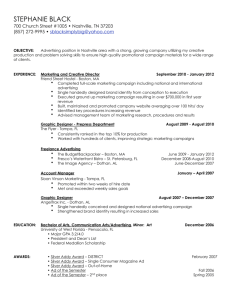Media Plan Template
advertisement

Media Plan Table of Contents 1. Introduction ............................................................................................................................. 3 1.1 Background ............................................................................................................................. 3 1.2 Useful Resources ..................................................................................................................... 3 2. Situational Analysis .................................................................................................................. 4 2.1 Strategic objectives ................................................................................................................. 4 2.2 Audience ................................................................................................................................. 4 2.3 Product market factors ........................................................................................................... 4 2.4 Legal and ethical requirements............................................................................................... 5 3. Advertising strategy .................................................................................................................. 6 3.1 Creative requirements ............................................................................................................ 6 3.2 Merchandising strategy........................................................................................................... 6 4. Media Strategy ......................................................................................................................... 7 4.1 Media objectives ..................................................................................................................... 7 4.2 Media vehicles ........................................................................................................................ 7 4.3 Media schedule ....................................................................................................................... 7 4.4 Media budget .......................................................................................................................... 8 4.5 Testing schedule...................................................................................................................... 8 5. Campaign evaluation strategy ................................................................................................... 9 1. Introduction The primary function of a media plan is to help organise the advertising campaign strategy into a single document that can be easily followed. It enables us to analyse which media vehicles will be used to deliver the advertising message to execute a particular media strategy. 1.1 Background [Instruction: Referring to ABMN’s Marketing Plan, briefly outline the products and services ABMN currently offers and the different media audiences targeted by ABMN. Consider the different marketing activities that have been conducted in the past and the types of media audiences for each of those activities.] 1.2 Useful Resources The following document may assist you in the development of this media plan: Advertising brief ABMN Marketing Plan (including ABMN’s products and services offering and target market segments) ABMN Sales Data 2. Situational Analysis Prior to developing an advertising campaing a situational analysis should be conducted to help identify the media audience, relevant product market factors, competitive situation and any legal and ethical requirements that need to be considered. 2.1 Strategic objectives [Instruction: State our goals, that is, what are we trying to accomplish? Are our goals long term or short term? Write SMART objectives that are results-oriented and concrete so that they can be measured. Remember that ultimately we are trying to ready key audiences through our advertising message.] 2.2 Audience Identify the characteristics of the target audience for the media campaign to develop a consumer profile. Consider each of the following: 2.2.1 Demographic factors [Instruction: Consider the demographic factors (i.e. age, gender, education, income, etc.) of the primary target audience for this media campaign] 2.2.2 Psychographic factors [Instruction: Consider the psychographic factors (i.e. lifestyle, values, opinions, interests and attitudes) of the primary target audience for this advertising campaign] 2.2.3 Geographic factors [Instruction: Consider the geographic factors (i.e. where a consumer lives and/or works) of the primary target audience for this advertising campaign.] 2.2.4 Behavioural factors [Instruction: Consider the behavioural factors (i.e. benefits sought by the consumer, loyalty status, etc.) of the primary target audience for this advertising campaign] 2.2.5 Media audience [Instruction: Taking into consideration each of the factors identified above, describe the media audience/s for this particular advertising campaign.] 2.3 Product market factors Analyse the following factors to determine the reach and frequency required for each of the advertising media suggested in the brief. Consider the following factors: 2.3.1 Product characteristics [Instruction: Provide details of the product characteristics, such as product features, price and convenience and how they compare to similar product offerings of our competitors.] 2.3.2 Level of audience involvement [Instruction: Provide details of the level of audience involvement required in the process of selecting this product. Is the product cheap or expensive? Does it require a high level of decision making prior to making the purchase? Will the audience be required to conduct extra research prior to committing to buy the product?] 2.3.3 Product usage and life cycle [Instruction: Evaluate the product’s usage and life cycle. Is the product being offered currently used/available? Is it desired among the target audience? Is the product at the introductory, growth, maturity or decline stage of the product life cycle?] 2.3.4 Competitive situation [Instruction: Evaluate how competitive the product is, highly competitive or not?] 2.3.5 Media strategies [Instruction: Provide details of the media strategy that will be used, that is, differentiated or nondifferentiated. . 2.3.6 Reach and frequency requirements [Instruction: Using the information you have obtained from your review of the above product market factors outline the suggested reach and frequency requirements of this advertising campaign in the table below.] Reach and frequency application Emphasis on Reach Emphasis on Frequency Differentiated vs Non-differentiated Y/N Y/N Audience involvement Y/N Y/N Product usage/demand for product Y/N Y/N New product Y/N Y/N Advertising message Y/N Y/N Competitive environment Y/N Y/N 2.4 Legal and ethical requirements [Instructions: Identify two legal and two ethical constraints that may impact on the development of the media plan. Consider cultural influences, legislative requirements (such as WHS), social responsibilities and relevant codes of practice.] 3. Advertising strategy [Instruction: Provide details of the advertising message characteristics. Will the advertising message be simple or complex, ongoing or short term, unique or not? What is the current media environment as it relates to the product? Is the media environment cluttered? Will your advertisement be competing with other similar advertisements in your chosen media environment?] 3.1 Creative requirements [Instructions: Identify the creative requirements of the advertising message. These may include colour, the electronic or physical form, intrusive medium, longer and more profitable space and/or time requirements. Be creative but be sure to consider the media audience — small business operators. How can we best attract their attention but still be seen as the professional business that we are?] 3.1.1 Media implications of creative requirements [Instruction: Analyse the above creative requirements and determine the possible media implications associated with their use.] 3.2 Merchandising strategy [Instructions: Identify any possible media merchandising strategies that can accompany this advertising campaign. Can we offer the clients a free seminar, training session, product as part of the membership? What expos or events can be used to promote our product? How else can we sell this product and maximise the return on investment of this advertising campaign? Think strategically.] 4. Media Strategy 4.1 Media objectives [Instruction: Develop a statement(s) that explain the goals of the media plan, for example, what is the percentage or number of the target audience that will be exposed to the advertising message in a given period (reach) and how often (frequency).] 4.2 Media vehicles [Instructions: Review previous marketing activities (which can be found in the current Marketing Plan) to identify four media vehicles that might be suitable for this advertising campaign. Weigh up the merits of each media vehicle selected, taking into account the principles and characteristics of each, to assist you to determine the most appropriate ones.] 4.2.1 Rationale [Insturctions: Provide a rationale to support your selection. You may also need to include a rationale for any media vehicles you have not considered – for example, did not include newspaper due to increasing costs and declining readership. Your rationale should include how the media vehicles: target the selected audience meet the merchandising strategies meet creative requirements meets legal and ethical requirements work to ensure the reach and frequency requirements of the campaign are met fit within the budget]. 4.3 Media schedule Develop two media schedules to present to the client that meet the requirements of the advertising brief and are within the allocated budget. Each schedule should emphasise different media vehicles at different times. This will allow the client to select an alternative schedule to maximise the return on investment throughout the advertising campaign based on testing results. Media schedule 1 will be the schedule we will commence with. [Instruction: Consider different strategies for scheduling broadcast advertising (e.g. continuity across advertising period, pulsing or staggered/stepping. How will you determine the most effective reach and frequency requirements for your target audience? What media vehicles will be most effective and how will you place the ads to maximise your marketing spend? The table below may help you to document the proposed media schedule.] Week 5 Week 4 Week 3 Week 2 Week 1 Week 5 Week 4 Month 3 Week 3 Week 2 Week 1 Week 5 Week 4 Month 2 Week 3 Week 2 Media Vehicle Week 1 Month 1 E.g. Radio – ABC – 30 secs 4.4 Media budget [Instruction: Review the budget provided and confirm whether it is sufficient to achieve the advertising campaign objectives.] Advertising period Media Vehicle Cost (per period) Total 4.5 Testing schedule [Instruction: Determine a schedule to test the advertising campaign over the life of the campaign (three months). Testing should occur regularly to ensure modifications can be made and alternative media schedules implemented as required. The aim of the testing schedule is to provide us with the necessary data to modify our advertising campaign as required to ensure its effectiveness and get the biggest bang for our buck. The table below may help you when developing the testing schedule] E.g. Focus group survey Week 5 Week 4 Week 3 Week 2 Week 1 Week 5 Week 4 Month 3 Week 3 Week 2 Week 1 Week 5 Week 4 Month 2 Week 3 Week 2 Testing method Week 1 Month 1 5. Campaign evaluation strategy [Instruction: Using the strategic objectives developed in Section 2.1 , identify at least two evaluation measures that can be used to assess the effectiveness of the advertising campaign at the end of the campaign.] Objective Evaluation strategy



